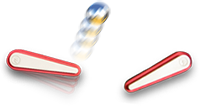Welp, it's my first pin! I've been pinball obsessed for a bit over a year now, and as an artist/tinkerer at heart it was only a matter of time till I dove into the rabbit hole of restoration. An awesome local Pinsider offered me a great deal on this project Bally Star Trek. It came without a backglass and with boards in unknown condition, but the first challenge was just fitting it in my tiny Chicago apartment!
Here's the machine in my workshop:
IMG_0952.JPG
WARNING: This thread is going to be pic heavy and probably a bit overly detailed, as I'm doing this documentation for newbs like myself who are doing this for the first time.
The playfield has numerous bare spots, which i'm planning on replacing entirely with a custom printed overlay. I'm wanting to get the opinion of you professionals, however, if this level of ware warrants a sand-down or if you believe it could be saved by a proper paint match (which I myself am highly unconfident of).
IMG_1185.JPG
Several folks have DEFINITELY lost their entire glasses of beer down the front of this machine at some point, judging by this rust on the coin door:
IMG_1189.JPG
Obviously the coin mechs are also missing, as somebody has converted this machine to free-play. I believe i'll be reverting it back to it's coin operated state, but with the addition of a hidden credit button.
The coin door skin has apparently seen a few too many slam tilts, or something. Luckily I have a new one on the way courtesy of another great Pinsider.
The cabinet art condition will definitely call for a re-paint. I intend on printing my own stencils, which is where the "custom" comes into play. More on that later.
IMG_1341.JPG
The tilt bob was completely detached, so why was the coin door so slammed in!? (the bulbs & plunger spring clutter is my own, after having gone over the machine with a tune-up kit)
IMG_1208.JPG
The boards were named as "untested" upon purchase and came disconnected from the game. From my two months of preparatory research, critical circuit board failure was one of my biggest fears in purchasing my first pin. Battery corrosion, specifically. (although thanks to the low price of the pin, I was fully prepared to buy some replacement boards).
As you can porbably see above, former battery corrosion was indeed an issue. It looks to have been cleaned up by a previous owner, however, and fortunately things have gone well so far. After following numerous guides from PinWiki and other sources on how to power up a pin for the first time, I was very excited to see this:
IMG_0977.JPG
That's GI only at that point. The MPU was not booting up. The original rectifier board was functional with good voltage levels, and also showed good voltage on the solenoid driver board. No power was getting to the MPU though.
After more googling, I tested the MPU using a computer power supply and actually got it to boot & throw the proper LED flash sequence. So I ordered some connector re-pin kits and also complete high/low voltage re-build kits for the solenoid driver board. I had some decent soldering experience prior to this but was very pleased to see how easy these component swaps actually are. It's very well documented online and Big Daddy Enterprises makes it pretty much foolproof with their kits & instructions.
After those adjustments, IT'S ALIVE! It flips, it scores, it plays. I actually don't have any pics to reference it, but it was a great moment in my pinball career!
I had some display issues where a fuse was blowing, but I narrowed it down to 1 display that must have a short. The others all work fine except for a stuck segment on one of them.
Anyway, though, the playfield mechanisms are actually all in pretty great shape and seemingly clean. One of the slings was out due to a broken coil plastic (the part where the lugs are located, and the coil wire was severed). I've since replaced that coil and now the sling works nicely.
Oh, here's a pic of the broken sling coil I mentioned that has since been replaced:
IMG_1103.JPG
Upon the suggestion of a local pinball technician & friend (shout out to James at Logan Arcade in Chicago), I went ahead and just replaced the rectifier board. I agree with him that the power train should be solidified all the way through, and since I already did the high/low voltage on the solenoid driver board, the rectifier for $70 really made sense. Great Plains was out of stock, so I went with the PinHead brand board from Pinball Resource.
I've since also ordered a new power cord, power switch, and varistor for safe keeping.
Anyway, I guess that sums up the initial adoption of the machine.
Oh, I suppose I should share this photo of some previous tenants of this machine. This was one of 4 wasps nests I found within:
IMG_1199.JPG


 Santa Monica, CA
Santa Monica, CA
 Salisbury
Salisbury
 Sana'a
Sana'a
 Moorefield, ON
Moorefield, ON

